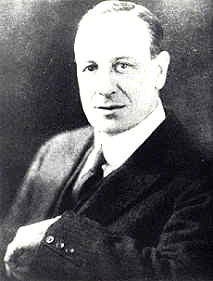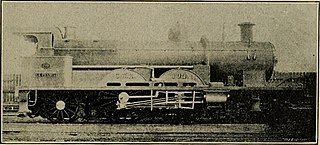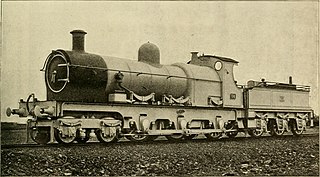
The 4073 or Castle Class are 4-6-0 steam locomotives of the Great Western Railway, built between 1923 and 1950. They were designed by the railway's Chief Mechanical Engineer, Charles Collett, for working the company's express passenger trains. They could reach speeds of up to 100 mph (160 km/h).

George Jackson Churchward was an English railway engineer, and was chief mechanical engineer of the Great Western Railway (GWR) in the United Kingdom from 1902 to 1922.
The Great Western Railway 3800 Class, also known as the County Class, were a class of 4-4-0 steam locomotives for express passenger train work introduced in 1904 in a batch of ten. Two more batches followed in 1906 and 1912 with minor differences. They were designed by George Jackson Churchward, who used standard components to produce a four-coupled version of his Saint Class 4-6-0s.

The Great Western Railway (GWR) 4200 Class is a class of 2-8-0T steam locomotives.

The Great Western Railway (GWR) 6959 or Modified Hall Class is a class of 4-6-0 steam locomotive. They were a development by Frederick Hawksworth of Charles Collett's earlier Hall Class named after English and Welsh country houses.

The Great Western Railway (GWR) 2800 Class is a class of Churchward-designed 2-8-0 steam locomotive.

The GWR 5600 Class is a class of 0-6-2T steam locomotive built between 1924 and 1928. They were designed by Charles Collett for the Great Western Railway (GWR), and were introduced into traffic in 1924. After the 1923 grouping, Swindon inherited a large and variable collection of locomotives from historic Welsh railway companies, which did not fit into their standardisation programme. GWR boiler inspectors arrived en masse and either condemned the original locomotives or had them rebuilt. The systematic destruction of many examples of locomotives, most still in serviceable condition, followed, but various were worked alongside 5600 Class.

The Great Western Railway (GWR) 2221 Class or County Tank was a class of 4-4-2T steam locomotive, effectively a tank engine version of the 3800 "County" Class 4-4-0 tender locomotives. The two classes had different boilers, standard no 4 for the tender locomotive, and the smaller standard no 2 for the tank. 2230 was fitted with the larger boiler when new, but this was unsuccessful and was quickly altered.

The Great Western Railway (GWR) 2301 Class or Dean Goods Class is a class of British 0-6-0 steam locomotives.

Charles Benjamin Collett was Chief Mechanical Engineer of the Great Western Railway from 1922 to 1941. He designed the GWR's 4-6-0 Castle and King Class express passenger locomotives.
The Great Western Railway (GWR) 3600 Class was a class of 2-4-2T side tank steam locomotive, designed by William Dean and built at Swindon in three lots in 1900-1903:
The GWR 0-6-0PT, is a type of steam locomotive built by the British Great Western Railway with the water tanks carried on both sides of the boiler, in the manner of panniers. They were used for local, suburban and branch line passenger and goods traffic, for shunting duties, and as banker engines on inclines. The early examples, such as the 1901 and 2021 classes, were rebuilt from saddle or side tanks when the locos received a Belpaire firebox – this type of firebox has a square top and is incompatible with a curved saddle tank. This process mostly took place during the tenure at Swindon Works of George Jackson Churchward. Only a very small number of saddle tank locomotives escaped rebuilding as panniers, notably the 1361 Class built new under Churchward in 1910, by which date a few of the 1813 Class had already been rebuilt as pannier tanks.
The GWR was the longest-lived of the pre-nationalisation railway companies in Britain, surviving the 'Grouping' of the railways in 1923 almost unchanged. As a result, the history of its numbering and classification of locomotives is relatively complicated. This page explains the principal systems that were used.

James Holden was an English locomotive engineer.

The GWR 2721 Class was a class of 0-6-0ST steam locomotives. They were designed by William Dean and built at the Swindon Works of the Great Western Railway between 1897 and 1901.

La France, number 102, was a locomotive of the Great Western Railway. It was bought by G.J. Churchward to evaluate French locomotive practice, and particularly the effect of compounding.

GWR No. 36 was a prototype 4-6-0 steam locomotive constructed at Swindon Works for the Great Western Railway in 1896, the first 4-6-0 ever built for the GWR and one of the first in Britain. It was designed by William Dean and le Fleming comments that "the design is unusual and entirely Dean of the later period, including the only large boiler ever built entirely to his ideas."

The Great Western Railway (GWR) 3901 Class is a class of 2-6-2T steam locomotives rebuilt from class 2301 'Dean Goods' 0-6-0 tender locomotives.
The Great Western Railway (GWR) experimented with oil burning steam locomotives at two points in its history. A single experimental tank engine was constructed to burn oil in 1902, and 37 engines of four different classes were converted to burn oil between 1946 and 1950. Neither experiment resulted in the long-term use of oil as fuel for steam locomotives. A single pannier tank locomotive was also converted under British Rail in 1958.














